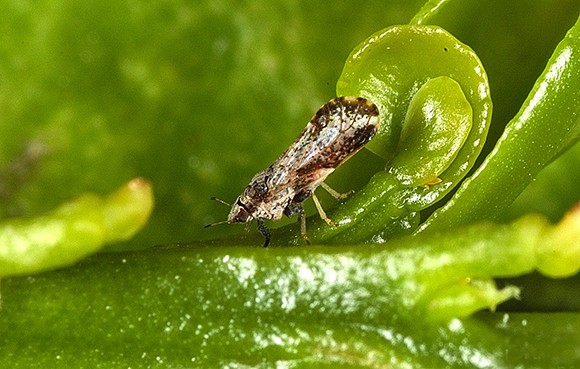Disease-carrying citrus psyllid found in SLO County

The Asian citrus psyllid, a small insect that transmits a disease fatal to citrus trees, has been discovered in a trap near Arroyo Grande. (United States Department of Agriculture photo)
The Asian citrus psyllid, a tiny pest that spreads a disease fatal to citrus trees, has been discovered in San Luis Obispo County for the first time.
The bug was found in an insect trap at a home near Arroyo Grande, the San Luis Obispo County Department of Agriculture said on April 1, prompting agricultural officials to kick off a high-density trapping effort. The state Department of Food and Agriculture will place the area under quarantine in an attempt to stop the spread of the pest. Santa Barbara and Ventura counties are already quarantined, along with other areas in California.
SLO County farming officials said they will begin an effort to eradicate the bug. The psyllid is a small insect that spreads Huanglongbing, a bacterial disease that is deadly to citrus trees. The pest was first found in California orchards in San Diego in 2008, and has steadily made its way up the coast since.
The disease itself has only been detected once in California — in a tree in Los Angeles in 2012 — but in other parts of the world, the infection has invariably followed the psyllid.
The disease poses no danger to humans or animals, but it has devastated millions of acres of citrus crops throughout the United States and abroad. In Florida, about half of the state’s commercial citrus groves have been wiped out over the last 10 years as a result of the disease. The University of Florida estimates that Huanglongbing has resulted in the loss of more than 6,600 jobs, $1.3 billion in revenue to growers and $3.6 billion in economic activity for the state.
Ventura County, the No. 1 lemon-producing county in the nation, has more than 20,000 acres of lemons, oranges, tangerines and grapefruit, crops that generate roughly $215 million annually. Santa Barbara has about 1,400 acres of lemons. The value of the crop in 2012 was more than $10 million.
San Luis Obispo County’s 1,591-acre lemon crop was valued at $9.1 million in 2012.
Huanglongbing, also known as citrus greening disease, affects all types of citrus. “This includes citrus trees in countless landscapes across the county as well as local commercial citrus orchards valued at over $13 million in 2013,” Martin Settevendemie, agricultural commissioner for SLO County, said in a statement.
County officials are working with commercial farms to monitor for the psyllid. They are also asking residents with backyard citrus trees to look out for the pest and requesting that people buy locally grown citrus and respect the boundaries of the quarantine.
“It is difficult to close off all potential pest pathways into the county,” Settevendemie said.
In December, the U.S. Department of Agriculture created an emergency response framework to address the disease and facilitate cooperation among citrus-growing states.
For more information on the Asian citrus psyllid, visit the California Department of Food and Agriculture website or the San Luis Obispo County Agricultural Commissioner’s website.










